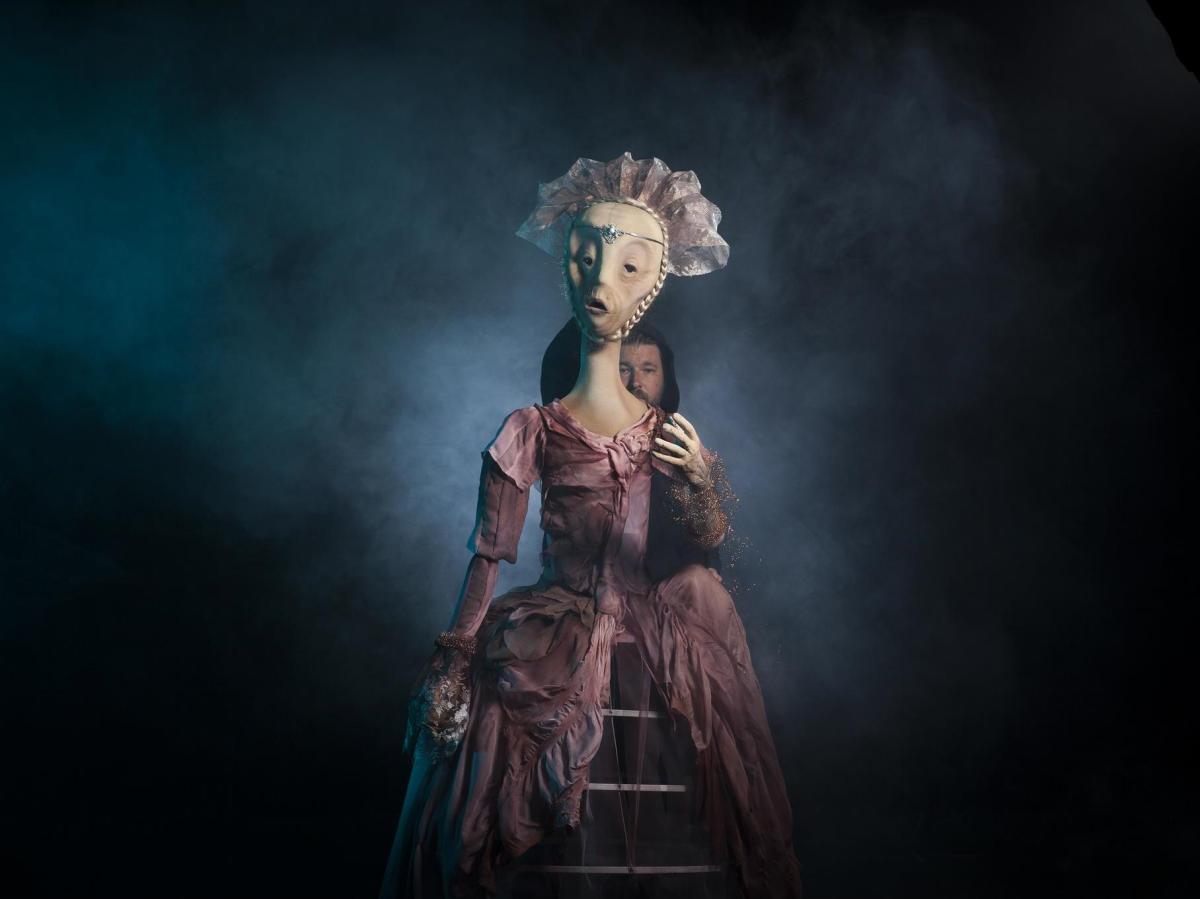Photo credit: Charlie Kinross. Image courtesy of Victorian Opera and Dark Mofo.
This collaboration between the Victorian Opera and the Tasmanian Symphony Orchestra is a fulsome, wild fairytale carnival and music hall riot. A simultaneously modern and 14th Century melodrama brought to life by evocative operatic crescendos, a live orchestra, and some of the most endearing puppets you’re ever likely to see on an opera stage.
That, however, depends greatly on where you are sitting.
As beautiful, ornate and atmospheric as it is, The Theater Royal can be an unforgiving stage for a large work that spans its girth and depth. For the audience who is craning in the higher seats to take in the action, and follow the narrative, the nuances of the work are lost due to problematic sightlines and performers playing front and low.
My experience began with a seat in the right side higher gallery and ended in the stalls down stairs. The Sleeping Beauty is a very different experience in each.
My position in the gallery prevents me from viewing the entire right side of the stage, including any view of the chorus and puppetry work staged on a significant piece of multi-tiered set, and any floor work centre stage.
To direct/restage in this space and connect beyond the stalls and the front centre rows of the dress circle and gallery is a challenge.
Due to some deft work by front of house and festival staff I saw the second part in a centre stall seat, which transformed my experience significantly. Not only because it provided a full view of the stage, but also as it provided an immersive and connected experience. Cheeky play between the puppeteers and the singers, intricate details in the endearing King’s face and the fulsome embracing of voice in the singers’ bodies open up the story.
This telling of Sleeping Beauty, a rarely performed opera, is unique and wonderful, not only because Rostretti originally imagined the story told in partnership with marionettes, but also because of the curious melding of Germanic influences and Italian language.
This is not the cartoon or children’s storybook version of Perrault’s classic Sleeping Beauty we remember as children, where a beautiful prince rescues an equally beautiful young woman and whisks her away on a white horse. But Respighi’s version is clearly one enthusiastically enjoyed equally by children and adults.
The work strikes a delicate balance of modern references (Donald Trump pushing his way in with a desperately oversized tie) with poetic allusions to rites of spring, fertility and the vigilant quest of a hero. In this version we see that hope and love triumph over money and that adversity can be conquered with hope and resilience when our sleeping beauty awakes 600 years later.
It’s an innovative and accessible opera made spectacular by Joe Blanck’s superb puppets and their puppeteers. Particularly the spider monster and the tree man bring a sense of the epic, provoking gasps from the young girls sitting next to me.
The carnie in me couldn’t quite help but wish that the spectacle and epic were elevated by a few acrobatic explorations of Blanck and Bluebottle’s set, however the physical performers/dancers climbed, spun and lifted their way through the fairytale landscape like it was a playground, which was a delight to see and a testament to Michelle’s Heavens eye and Nancy Black’s direction.
Phillip Lethlean’s lighting casts a warm golden glow over the story, and the play between the set and lighting, and its incorporation into the puppetry is lush and imaginative. The work’s design is a strength – however a minor quibble was that at times small details such as the colour choices on the casually dressed performers, or a hat that over-shadowed a face distracted from what was otherwise such a cohesive design.
Director Nancy Black’s skill ensures that the world of the piece and the play between its complex elements are seamless and collaborative. It works most powerfully when the puppeteers match the energy of the singers (a special nod to Liane Keegan and Elizabeth Barrow) and hold the same emotive robustness in their embodiment of the puppets. Or in the cheeky, equally matched energy of the two princes (Carlos E Barcenas and Vincent Crowley) as they collaboratively share the story of the quest with us.
At times you longed to see the theatre of the orchestra, another constraint of the venue, however the TSO and their brilliant conductor Phoebe Briggs made their presence known and enjoyed right up into the rafters.
Like Dark Mofo itself, Ottorino Respighi’s The Sleeping Beauty is an exploration of new ideas and of transforming artforms. Like Dark Mofo it’s part dance hall, part spectacular Bacchanalian celebration and is the catalyst for the coming together of diverse elements, and diverse audiences.
A joy to experience (from the right seats).
4 stars out of 5
Ottorinoa Respighi’s The Sleeping Beauty
Victorian Opera + Tasmanian Symphony Orchestra
Presented as part of Dark Mofo
Composer: Ottorino Respighi
Librettist: Gian Bistolfi
Director: Nancy Black
Puppet design and construction: Joe Blanck
Set Design: Blue Bottle/Ben Cobham/Joe Blank
Lighting Designer: Phillip Lethlean
Choreographic Consultant: Michelle Heaven
Theatre Royal, Hobart
Saturday 10 June, 2.30pm + 6pm
Sunday 11 June, 2.30pm
Dark Mofo
darkmofo.net.au
8-21 June 2017





